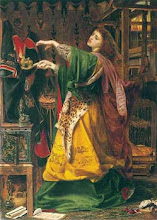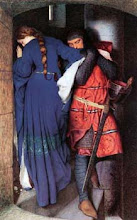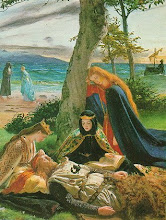
Whitsun (also Whitsunday, Whit Sunday or Whit) is the name used in the United Kingdom for the Christian festival of Pentecost, the seventh Sunday after Easter, which commemorates the descent of the Holy Spirit upon Christ's disciples (Acts of the Apostles chapter 2). In England it took on some characteristics of Beltane, which originated from the pagan celebration of Summer's Day, the beginning of the Summer half-year in Europe.
The name is a contraction of “White Sunday”, attested in “The Holy-Ghost”, which thou did send on “Whit-Sunday” in the Old English homilies, and parallel to the mention of hwitmonedei in the early 13th-century Ancrene Riwle. Walter William Skeat noted that the Anglo-Saxon word also appears in Icelandic hvitasunnu-dagr, but that in English the feast was always called Pentecoste until after the Norman Conquest, when white (hwitte) began to be confused with wit or understanding.
Excerpt from The Acts of King Arthur and his Noble Knights by John Steinback
King Arthur held Whitsun court at Winchester, that ancient royal town favored by God and His clergy as well as the seat and tomb of many kings. The roads were clogged with eager people, knights returning to stamp in court the record of their deeds, of bishops, clergy, monks, of the defeated fettered to their paroles, the prisoners of honor. And on Itchen water, pathway from Solent and the sea, the little ships brought succulents, lampreys, eels and oysters, plaice and sea trout, while barges loaded with casks of whale oil and casks of wine came tide borne. Bellowing oxen walked to the spits on their own four hooves, while geese and swans, sheep and swine, waited their turn in hurdle pens. Every householder with a strip of colored cloth, a ribbon, any textile gaiety, hung it from a window to flap its small festival, and those in lack tied boughs of pine and laurel over their doors.
In the great hall of the castle on the hill the king sat high, and next below the fair elite company of the Round Table, noble and decorous as kings themselves, while at the long trestle boards the people were as fitted as toes in a tight shoe. Then while the glistening meat dripped down the tables, it was the custom for the defeated to celebrate the deeds of those who had overcome them, while the victor dipped his head in disparagement of his greatness and fended off the compliments with small defensive gestures of his hands. And as at public penitence sins are given stature they do not deserve, little sins grow up and baby sins are born, so those knights who lately claimed mercy perchance might raise the exploits of the brave and merciful beyond reasonable gratitude for their lives and in anticipation of some small notice of value.
This no one said of Lancelot, sitting with bowed head in his golden-lettered seat at the Round Table. Some said he nodded and perhaps dozed, for the testimony to his greatness was long and the monotony of his victories continued for many hours. Lancelot’s immaculate fame had grown so great that men took pride in being unhorsed by him—even this notice was an honor. And since he had won many victories, it is possible that knights he had never seen claimed to have been overthrown by him. It was a way to claim attention for a moment. And as he dozed and wished to be otherwhere, he heard his deeds exalted beyond his recognition, and some mighty exploits once attributed to other men were brought bright-painted out and laid on the shining pile of his achievements. There is a seat of worth beyond the reach of envy whose occupant ceases to be a man and becomes the receptacle of the wishful longings of the world, a seat most often reserved for the dead, from whom neither reprisal nor reward may be expected, but at this time Sir Lancelot was its unchallenged tenant. And he vaguely heard his strength favorably compared with elephants, his ferocity with lions, his agility with deer, his cleverness with foxes, his beauty with the stars, his justice with Solon, his
stern probity with St. Michael, his humility with newborn lambs; his military niche would have caused the Archangel Gabriel to raise his head. Sometimes the guests paused in their chewing the better to hear, and a man who slopped his metheglin drew frowns.
Arthur on his dais sat very still and did not fiddle with his bread, and beside him sat lovely Guinevere, still as a painted statue of herself. Only her inward eyes confessed her vagrant thoughts. And Lancelot studied the open pages of his hands—not large hands, but delicate where they were not knobby and scarred with old wounds. His hands were fine-textured—soft of skin and very white, protected by the pliant leather lining of his gauntlets.
The great hall was not still, not all upturned listening. Everywhere was movement as people came and went, some serving huge planks of meat and baskets of bread, round and flat like a plate. And there were restless ones who could not sit still, while everyone under burden of half-chewed meat and the floods and freshets of mead and beer found necessity for repeated departures and returns.


































